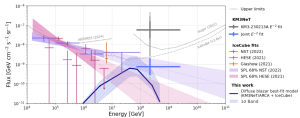21 November 2025 – We present a new paper with the title ‘Blazars as a Potential Origin of the KM3-230213A Event‘.
In the paper, we test the hypothesis that the ultra-high-energy neutrino KM3-230213A could come from the diffuse neutrino emission of blazars.
To explore this possibility, the blazar emission is simulated modelling particle acceleration and interactions inside the relativistic jet of the blazar. Two key free parameters are varied: the baryonic loading η and the proton spectral index αp.
From the simulated spectra, the diffuse neutrino and gamma-ray fluxes of the entire blazar population are calculated by integrating over the Fermi-LAT gamma-ray luminosity function and the source redshift distribution.
A combined multimessenger likelihood analysis is then performed considering both the ‘neutrino likelihood’ and the ‘gamma-ray likelihood’.
The neutrino likelihood represents the likelihood that the predicted diffuse flux can explain the single KM3-230213A neutrino event while remaining compatible with IceCube’s non-observation at the same energies.
The gamma-ray likelihood represents the likelihood that the associated diffuse gamma-ray emission of the blazar does not exceed the extra-galactic gamma-ray background measured by Fermi-LAT.
The analysis shows that, for the best-fit parameter values η ≈ 10, and αp ≈ 1.8, a population of blazars can indeed produce a diffuse neutrino flux which can explain the KM3-230213A event, without exceeding gamma-ray observations. A KM3NeT-only analysis remains compatible with Fermi-LAT data.
The paper has been submitted to Journal of Cosmology and Astroparticle Physics and is available as a preprint at arXiv: 2511.13886
In the picture the diffuse spectral energy distribution for blazars is shown in terms of the energy for a single neutrino flavour. The dark blue solid line represents the best fit, while the shaded region is the 1σ band. The prediction is compared with the KM3-230213A event and with results of other observatories.


